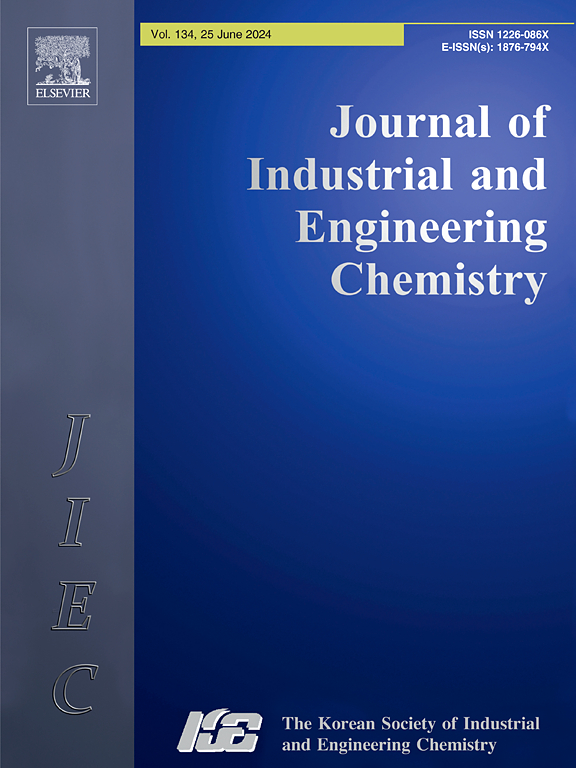Enhanced photocatalytic decomposition of azo-dyes using 2D g-C3N4 nanosheet/PVDF films: Comparative analysis of immobilization methods and recyclability
IF 5.9
3区 工程技术
Q1 CHEMISTRY, MULTIDISCIPLINARY
Journal of Industrial and Engineering Chemistry
Pub Date : 2025-02-21
DOI:10.1016/j.jiec.2025.02.042
引用次数: 0
Abstract
This paper reports on the development of solar-responsive photocatalytic films (CN/PVDF) for the decomposition of azo-dye wastewater. The as-synthesized films comprise the photocatalyst carbon nitride (g-C3N4 or CN) immobilized on the substrate polyvinylidene difluoride (PVDF) through three distinct fixation methods, i.e., blending (B), aperture blending (AB), and hot pressing (HP). This study investigates the characteristics of these films, evaluates their photocatalytic activity for the decolorization of acid red 1 (AR1) under simulated solar irradiation, and assesses their recycling potential. Experimentation on the AR1 decolorization of the three as-prepared films under 5 h of light exposure confirms the excellent photocatalytic activity of CN/PVDF-HP, which shows a photo-decolorization rate of 76.77%, possibly owing to the presence of the photocatalyst on the PVDF surface. Moreover, CN/PVDF-HP retains 91% of its initial AR1-decolorization rate after two consecutive photo-decolorization cycles, confirming excellent stability during AR1-decolorization testing. All the CN/PVDF films exhibit moderate recyclability and stability on decomposition cycling. Therefore, the three as-prepared photocatalyst-loaded films show comparable performance and recyclability, exhibiting high potential for continuous water purification. The results of this study could guide future research on the development of high-performance wastewater treatment technologies.

利用二维g-C3N4纳米片/PVDF膜增强偶氮染料的光催化分解:固定化方法和可回收性的比较分析
本文报道了用于分解偶氮染料废水的光催化膜(CN/PVDF)的研制。合成的膜由光催化剂氮化碳(g-C3N4或CN)通过三种不同的固定方法固定在基底聚偏氟乙烯(PVDF)上,即共混(B),孔径共混(AB)和热压(HP)。本文研究了这些膜的特性,评价了它们在模拟太阳辐照下对酸性红1 (AR1)脱色的光催化活性,并评估了它们的回收利用潜力。对制备的三种膜在5 h光照下进行AR1脱色实验,证实了cn /PVDF- hpt具有优异的光催化活性,其光脱色率达到76.77%,这可能是由于光催化剂存在于PVDF表面所致。此外,在连续两次光脱色循环后,CN/PVDF-HP仍保持了91%的初始ar1脱色率,证实了在ar1脱色测试中的优异稳定性。所有的CN/PVDF薄膜在分解循环中表现出中等的可回收性和稳定性。因此,制备的三种负载光催化剂的膜具有相当的性能和可回收性,在连续水净化方面具有很高的潜力。本研究结果可指导未来高效废水处理技术的开发研究。
本文章由计算机程序翻译,如有差异,请以英文原文为准。
求助全文
约1分钟内获得全文
求助全文
来源期刊
CiteScore
10.40
自引率
6.60%
发文量
639
审稿时长
29 days
期刊介绍:
Journal of Industrial and Engineering Chemistry is published monthly in English by the Korean Society of Industrial and Engineering Chemistry. JIEC brings together multidisciplinary interests in one journal and is to disseminate information on all aspects of research and development in industrial and engineering chemistry. Contributions in the form of research articles, short communications, notes and reviews are considered for publication. The editors welcome original contributions that have not been and are not to be published elsewhere. Instruction to authors and a manuscript submissions form are printed at the end of each issue. Bulk reprints of individual articles can be ordered. This publication is partially supported by Korea Research Foundation and the Korean Federation of Science and Technology Societies.

 求助内容:
求助内容: 应助结果提醒方式:
应助结果提醒方式:


